Advertisements
Advertisements
Question
The capacitance between the adjacent plates shown in the figure is 50 nF. A charge of 1.0µC is placed on the middle plate. If 1.0 µC is placed on the upper plate instead of the middle, what will be the potential difference between (a) the upper and the middle plates and (b) the middle and the lower plates?
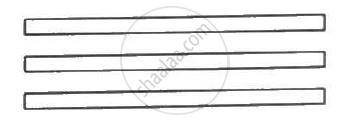
Solution
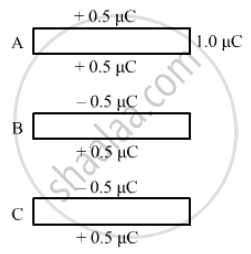
When 1µC charge is given to the upper plate, the charge gets distributed. The two sides of the upper plate have `+0.5 muC` charge. One side of the middle plate facing the upper plate has `-0.5 muC` charge and the other side has `+0.5 muC` Change . Similarly, one side of the lower plate facing the middle plate has `-0.5 muC` charge and the other side has `+0.5 muC` charge.
(a) Effective charge on the capacitor formed by the upper and middle plates = 0.5 µC
Capacitance = 50 nF = 0.05 µF
∴ Potential difference between the plates , `V = Q/C = (0.5 muC)/(0.05 muF) = 10 "V"`
(b) Effective charge on the capacitor formed by the middle and lower plates = 0.5 µC
Capacitance = 0.50 µF
∴ Potential difference between the plates, `V = Q/C = (0.5 muC)/(0.05 muF) = 10 "V"`
APPEARS IN
RELATED QUESTIONS
Draw a labelled diagram of Van de Graaff generator. State its working principle to show how by introducing a small charged sphere into a larger sphere, a large amount of charge can be transferred to the outer sphere. State the use of this machine and also point out its limitations.
In the figure shown, an ammeter A and a resistor of 4 Ω are connected to the terminals of the source. The emf of the source is 12 V having an internal resistance of 2 Ω. Calculate the voltmeter and ammeter readings.
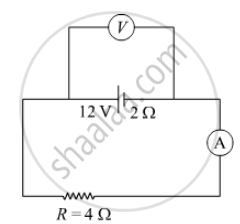
Both the capacitors shown in figure are made of square plates of edge a. The separations between the plates of the capacitors are d1 and d2 as shown in the figure. A potential difference V is applied between the points a and b. An electron is projected between the plates of the upper capacitor along the central line. With what minimum speed should the electron be projected so that it does not collide with any plate? Consider only the electric forces.
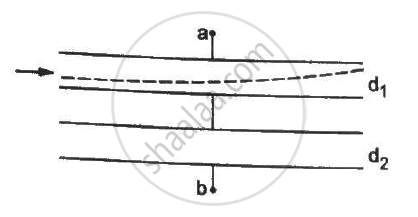
Find the potential difference `V_a - V_b` between the points a and b shown in each part of the figure.
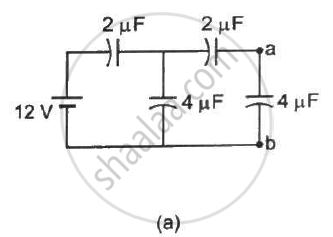
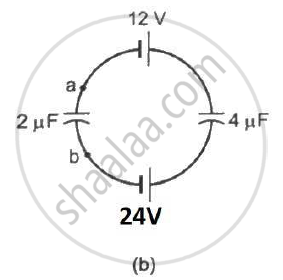
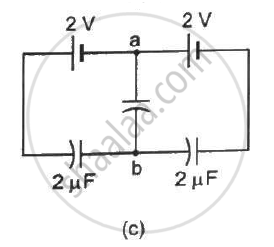
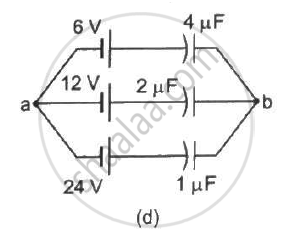
Find the potential difference between the points A and B and between the points B and C of the figure in steady state.

A charge of 20 µC is placed on the positive plate of an isolated parallel-plate capacitor of capacitance 10 µF. Calculate the potential difference developed between the plates.
A charge of 1 µC is given to one plate of a parallel-plate capacitor of capacitance 0⋅1 µF and a charge of 2 µC is given to the other plate. Find the potential difference developed between the plates.
The capacitance between the adjacent plates shown in figure is 50 nF. A charge of 1⋅0 µC is placed on the middle plate. (a) What will be the charge on the outer surface of the upper plate? (b) Find the potential difference developed between the upper and the middle plates.
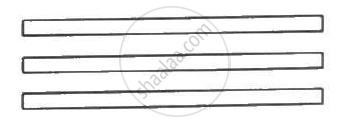
Two capacitors of capacitance 20⋅0 pF and 50⋅0 pF are connected in series with a 6⋅00 V battery. Find (a) the potential difference across each capacitor and (b) the energy stored in each capacitor.
A capacitor having a capacitance of 100 µF is charged to a potential difference of 50 V. (a) What is the magnitude of the charge on each plate? (b) The charging battery is disconnected and a dielectric of dielectric constant 2⋅5 is inserted. Calculate the new potential difference between the plates. (c) What charge would have produced this potential difference in absence of the dielectric slab. (d) Find the charge induced at a surface of the dielectric slab.
What will be the potential difference in the circuit when direct current is passed through the circuit?
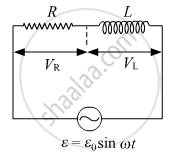
Assertion: Electric potential and electric potential energy are different quantities.
Reason: For a system of positive test charge and point charge electric potential energy = electric potential.
On moving a charge of Q coulomb by X cm, W J of work is done, then the potential difference between the points is ______.
A and B are two points in an electric field. If the work done in carrying 4.0C of electric charge from A to B is 16.0 J, the potential difference between A and B is:
An α-particle and a proton are accelerate at same potential difference from rest. What will be the ratio of their final velocity?
On moving a charge of 20 C by 2 cm, 2 j of work is done then the potential difference between the point is:-
Work done in moving a unit positive charge through a distance of x meter on an equipotential surface is:-
Can there be a potential difference between two adjacent conductors carrying the same charge?
